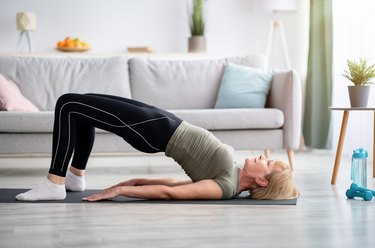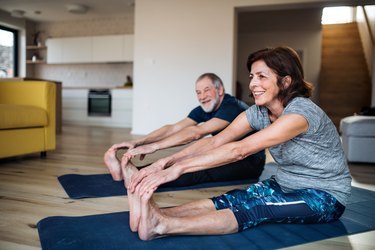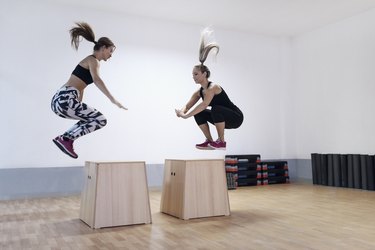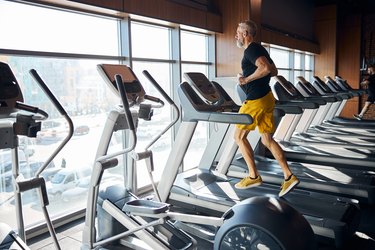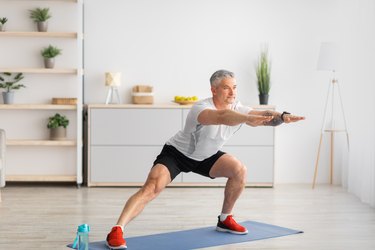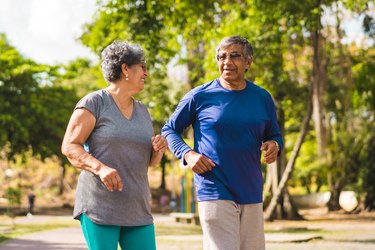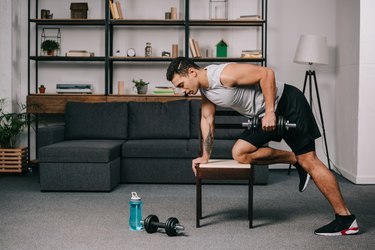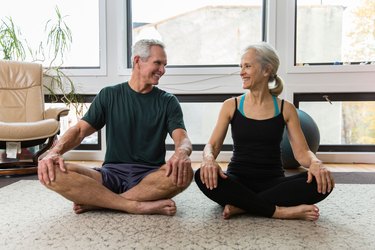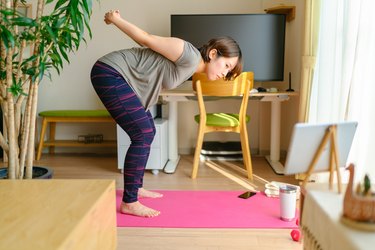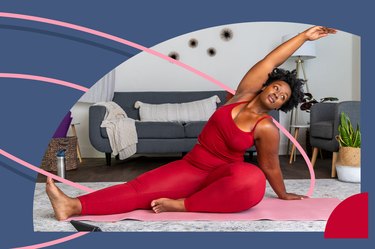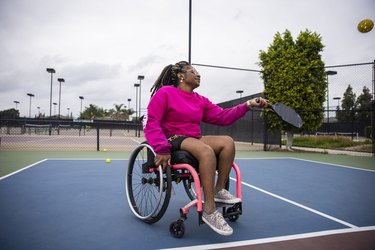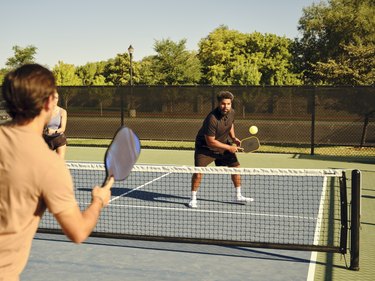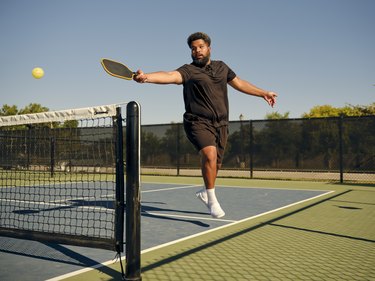
If you want to live more years — and have those years be better years — you've got to move, and move often.
Burning calories literally reduces your risk of death: In a study published in the British Medical Journal in 2019 that looked at 14,599 people, burning an extra calorie per kilogram of bodyweight per day was associated with a reduced risk of death by 24 percent.
Video of the Day
Video of the Day
So a person who weighs about 200 pounds can cut their risk of death by a quarter by burning just 90 more calories per day. That's the number of calories that person would burn by walking a little more than half a mile.
But when physical activity also helps maintain your strength in your legs, you don't just improve the amount of time you live, says Dan Ritchie, PhD, co-founder of the Functional Aging Institute. You've got a higher quality of life to look forward to during those extra years.
"The two critical pieces for thriving as we age are lower-body functional strength and lower-body functional power," he says. Functional means moving in lots of patterns and under different stressors.
"It's movements like stepping up and down things in different directions, with weights in different positions: forward, sideways, with a weight in front of you, over your head."
You can move like this in the gym, of course, but doing so on a court or field while playing sports offers an added bonus, says Darci Revier, CSCS, director of education for the National Exercise Trainers Association.
"One of the big things with an older population is the social and cognitive aspect of sport — creating a social bond," she says. "That's so important, because as we start to become isolated, not only do we see mental decline, but also physical decline. Because if we're not socially engaged and we stay home, we're not using our bodies as much."
Plus, sports are fun! Here's what it takes to thrive as we age — and seven sports you should try playing to have fun on the way.
4 Pillars of Aging Fit
To stay fit and active as we age, keeping the lower body strong is critical for a reason, Ritchie says.
"You need a critical amount of lower-body strength for daily activities of living," he says. "If you lose your lower-body strength, we don't even need to talk about things like going for a hike: getting out of a chair becomes a problem."
But there's more to thriving. Maintaining our fitness in four key areas can make our later years greater. Here's what you need to thrive, and how participating in sports can help.
1. Maintain Bone and Muscle Mass
There are two reasons we become frail: We lose muscle and bone mass.
Starting from the time we're around 40, adults begin to suffer from sarcopenia, another word for loss of muscle. The amount we lose is estimated to be up to 5 percent per year, but studies have found the number varies. At the same time, the density of our bones begins to reduce, both in men and women.
While the rates of each are unknown, we do know one way to slow both of these processes, Revier says.
"Maximize doing lower-impact, but weight-bearing, exercises can help with maintaining muscle and bone mass," she says. Translation: Exercises that challenge your muscles without jarring your joints and bones too much. Sports, she says, provide the perfect avenue.
2. Maintain Cardiovascular Fitness
According to an October 2018 study of more than 120,000 people published in JAMA Cardiology, cardiorespiratory fitness is inversely associated with the risk of death. So the fitter your ticker, the longer you'll live.
You'll know you have healthy heart if, according to Texas Health Resources, you can exercise without chest pain or shortness of breath and have steady energy levels throughout the day.
And unlike many other health interventions, more cardio fitness is always better. The authors of the JAMA Cardiology study said there was "no observed upper limit" to this benefit.
3. Maintain a Little Speed
"On thing that gets overlooked for older adults is power training," Revier says. That doesn't mean powerlifting, though. Strength is a measure of how much force you can produce (let's say, picking up 30 pounds). But power is a measure of how quickly you can produce that force.
"You have to be able to produce force with speed, or it becomes difficult to walk up a hill or a set of stairs," Ritchie says. "Playing games with your grandchildren is going to require a little bit of speed."
Being able to move with power also helps reduce injuries, Revier says. When you start to fall, reacting quickly to catch yourself requires muscular power — the same type that's trained and developed by many sports.
4. Maintain Joint Range of Motion
It's no secret that we get stiff as we age. And when it comes to joint mobility, Revier says, the old adage applies: Use it or lose it.
Most of our daily lives, though, don't encourage us to move our bodies through large and varying ranges of motion: We walk, sit, drive and maybe even run forward and backward. We're not moving to the sides, rotating our trunks, reaching far out to the sides or above our bodies. All of these types of movements happen in sport, though.
Revier points out that in racket sports, for example, you might have to reach for a ball, twist your body to hit a shot, and bend up and down as you try to reach balls. Sports that help practice these larger ranges of motion can help us maintain the ability to reach them as we age, so we stay limber.
7 Sports Older Adults Should Try
It can be intimidating to learn a new sport, especially if you don't consider yourself an athlete. We've taken care to list sports with welcoming, open communities — you're sure to find your footing with one (or more!) of the sports below.
1. Pickleball
The fastest-growing sport for older adults in the United States (and for Americans of all ages) is pickleball. According to the Sports & Fitness Industry Association's annual report, participation in this easy-to-learn racket sport has grown 158.6 percent of the past three years.
It's not just fun, Revier says — pickleball really can help with healthy aging.
"You're practicing coordination, agility … all great things that keep individuals able to live more independently, longer," she says. "Even the movement of the racket helps with wrist dexterity, upper body strength and mobility."
How to Get Started
If you haven’t tried the game yet, ask your friends — with how popular it’s become, one of them is sure to know. No luck? USA Pickleball’s website lists courts and lessons on its “Places 2 Play” site, and your local gym or YMCA likely has intro lessons.
2. Golf
Suggesting older folks play golf feels like a cliche, but it has powerful fitness benefits that go beyond simple walking.
"One advantage is that it's 100 percent outdoors," Ritchie ays. Moving outside has been shown to have benefits for our mental health in addition to physical health. But the golf course also provides unique physical benefits, he says.
"You have to walk across all kinds of contours of surface: You step over things, down from things, walk uphill and down slopes. All of these are great for our balance."
Swinging the club also trains our ability to rotate our trunks and move the upper body with power, Revier says.
How to Get Started
If you haven’t golfed before, the Professional Golfers’ Association (better known as the PGA) has a coach finding tool on their website.
3. Dancing
Whether you're line dancing or taking salsa lessons, you're getting all the benefits of walking — but with much more excitement, Revier says.
"We're also getting out of just moving forward and backward, what we call the 'sagittal plane' of motion. We've moving laterally, we're taking crossover steps," she says. "We're working a little bit of agility-type movement that's important to protect from falls and injury."
Dancing can also spur benefits between the ears.
"We're also incorporating cognitive challenges: Can you remember the steps?" she says. In the case of square dancing or line dancing, keeping track of the caller's instructions can help keep you sharp.
How to Get Started
Check with your local community center or cultural center to find a low-pressure dancing night to try it out.
4. Masters Track, Cycling and Swimming
The sports that comprise a triathlon aren't necessarily going to build gobs of functional strength and power, Ritchie says, but they benefit our hearts and our balance, and they get us outside.
"Anything people can do outdoors is an added benefit because there's an external stimulus," he says. "There's so much research that shows a benefit to our brains when we have to deal with environmental challenges."
You don't have to compete or race to enjoy these activities, but for competitive exercisers, they're great options, even if you're not an endurance athlete. Masters events in track and field and swimming are available for events of all lengths, from marathons and Ironman distances, of course, to sprints like the 100 meters.
And they're a great way to meet and interact with like-minded individuals — in each sport, group training in popular. You'll get to be part of a community and some built-in accountability.
How to Get Started
You can find Masters’ events for track and field at the USA Track and Field website. For swimming, check out U.S. Masters Swimming’s events page.
5. Tai Chi
Tai chi, controlled, specific movements, is another longtime favorite for seniors. But don't sleep on these slow movements, Revier says.
"It's obviously very low impact. It's very accessible. But it also incorporates a mind-body connection aspect of movement, and helps a lot with mobility … keeping those joints open and fluid," she says.
There's more, too: Scientists have done more than 500 studies on the benefits of tai chi, and have found it helps with balance (from standing on one foot), can benefit people with mental health challenges, like depression, and can reduce the risk of cardiovascular diseases and dementia.
How to Get Started
The non-profit Tai Chi Foundation has a class locator option, as well as online classes you can try at home to get started.
6. Croquet and Bocce
Lawn games may not be the first thing you think of when you hear "sports," but these backyard diversions are sneakily healthy.
"Even tossing a ball or swinging a mallet is helping with mobility in the shoulder, as well as trunk support and mobility through the hips," Revier says.
Another benefit? Bending over to pick up the balls over and over. "This is great for older adults because it's super functional: We have to get down and pick things up [in life]. Or we have to bend down to tie our shoes."
How to Get Started
These sports have a very low barrier to entry: Grab a bocce or croquet set on sale and find some friends and a plot of grass. Many city pubs also now offer bocce courts.
7. All the Other Racket Sports
"Tennis, racquetball, squash — all of these are going to have the components" for functional strength and power, Ritchie says.
Like pickleball, they'll help with agility, moving in lots of different directions, starting and stopping, moving fast and slow, building social bonds and more. The tougher sports, like tennis, can be scaled to your fitness level, too, he says: Doubles tennis, for instance, is less taxing than singles, because you've got less ground to cover.
Even table tennis can be scaled to be a fitness activity, Revier says: Play fast, and you'll definitely get out of breath after a few points.
How to Get Started
The U.S. Tennis Association (USTA) has a tool to find coaches, social games, and lessons on its website. And U.S. Squash has resources for masters tounament play and recreational play on its website.
